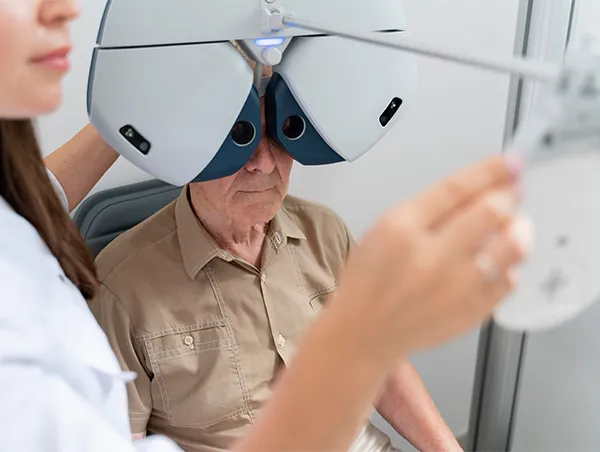EMDR Therapy in Edmonton That Helps You Process and Let Go
EMDR (Eye Movement Desensitization and Reprocessing) is a powerful tool for healing trauma. Our certified EMDR therapists in Edmonton guide you through each step safely, helping you release stuck emotions and find relief.
- Effective treatment for trauma, anxiety, and phobias
- Certified EMDR specialists with experience in complex trauma
- Calm, private sessions offered online or in person
World Of EMDR Therapy
We are happy to welcome you to the EMDR treatment world as a means of healing and emotional equilibrium. A cutting-edge treatment approach known as Eye Movement Desensitization And Reprocessing, or EMDR, offers relief from the emotional burden of trauma, anxiety, depression, and other problems. We know deep down that not all wounds are evident and that emotional scars can last a very long time. These unsaid battles can be addressed with the use of EMDR, and a safe atmosphere that encourages transformation can be established.

EMDR Therapy and Therapist
Our mental and emotional health might be negatively impacted by the emotional scars and painful events that life frequently hands us. EMDR treatment may be the key to your recovery if you are dealing with the effects of past trauma, anxiety, depression, or other psychological problems.
Our expert and EMDR certified therapist are committed to assisting you during this procedure, supporting you in uncovering the complications of your past, and applying the basis for a happier, more emotionally stable future. With EMDR, you can take back control of your life, get rid of uncomfortable symptoms, and find a level of resilience you might not have known you had.
EMDR is an effective therapeutic technique created to assist you in processing and overcoming upsetting memories. You will learn more about the complexity of EMDR treatment on this page, along with how it can help you feel better and speed up your recovery. Join us on this transformational journey as we embrace EMDR therapy’s healing potential.
Bharat Sharma, Therapist
The best EMDR therapist near me you can rely on at Edmonton Counseling Services is Bharat Sharma. He is the genuine deal when it comes to handling trauma and its effects! He has a wealth of knowledge and experience, and he is skilled at assisting people as they seek to recover from emotional traumas.
He is like a guiding light in the treatment community, equipped with strong EMDR methods and a kind heart. For his clients to open up and examine their emotional difficulties, he fosters a secure and nonjudgmental environment. He will walk with you through individualized EMDR treatment sessions, assisting you in comprehending and processing previous trauma and guiding you toward emotional well-being. He takes a pragmatic, real-world, and compassionate attitude. He is a firm believer in giving his patients the resources and encouragement they need to recover control over their emotional well-being.


What Are The Benefits Of Getting EMDR Therapy Sessions
Accepting EMDR therapy can change your life for the following reasons:
Effective Trauma Recovery: EMDR is a transforming journey rather than merely therapy. You will set out on a journey to recovery from past traumas with the help of your committed EMDR certified therapist, finding comfort where there once was anguish.
Short And Purposeful: EMDR is renowned for its effectiveness. You will see progress faster thanks to your therapist’s set of solution-focused goals and clearly defined stages. It is an effective substitute for lengthy therapy because the majority of patients report favorable changes after just a few sessions.
Circular Thinking, Depressive Symptoms, And Anxiety: Beyond trauma, EMDR’s effectiveness has been demonstrated by evidence. Your therapist will customize the care to address your particular needs and bring about lasting change, whether you are struggling with anxiety, depression, or circular thinking.
Fewer Talk, More Healing: EMDR’s distinctive methodology has been shown to hasten emotional healing in a manner similar to how our bodies heal from physical wounds. The best EMDR therapist near me will lead you through the procedure while minimizing the need for a lengthy conversation, turning emotional wounds into long-lasting settlements.
Explore the amazing advantages of EMDR treatment with us, and allow your therapist to be a part of your transformational journey.
What Are The Types Of Conditions EMDR Therapy Treats?
At our core, we comprehend the tremendous effects of trauma and that not all scars are obvious. With the help of our skilled therapist, Eye Movement Desensitization and Reprocessing (EMDR) therapy offers a revolutionary approach to a variety of problems.
EMDR is excellent for treating:
Traumatic Memories and PTSD: EMDR is very good at easing the burden of traumatic memories and the symptoms of PTSD.
Panic episodes and Persistent Anxiety: Take back control of crippling panic episodes and persistent anxiety.
Depression: In the fight against despair, discover hope and light.
Alcohol addiction and Eating Disorders: For long-lasting change, deal with the causes of addiction and eating problems.
According to research, EMDR may also be able to help people with more severe problems like bipolar disorder, anxiety disorders, psychosis, and even physical ailments like low back pain. Our knowledgeable therapist will assist you in utilizing EMDR therapy’s transforming potential for a better future and emotional well-being.


Preparation for EMDR Therapy
In order to start your EMDR therapy journey, it is important to keep the following in mind:
Reliving Traumatic Experiences
- You will be required to picture your life’s most trying times throughout EMDR sessions.
- Your therapist will lead you through this procedure while making sure you are at ease and secure.
- You do not have to intensely revisit your traumatic memories for lengthy periods of time as part of the therapy.
- Your skilled therapist will expertly control the intensity and progressively lessen distress.
- In order to receive effective treatment, be ready to return or recall your trauma several times.
Emotional and Mental Stress
- The initial sessions of EMDR therapy can be emotionally and mentally exhausting.
- For sustained efficacy, it is essential to maintain mental attention.
- EMDR frequently produces better and more long-lasting results than medication, despite the side effects, which could be problematic.
Temporary Emotional Distress
- Be prepared for a brief rise in your level of mental distress, which your therapist will help you manage with the appropriate strategies and instruments.
- Between sessions, troubling memories and unexpected reactions could return for some individuals.
- As your mind continues to analyze events, potential new emotions and memories may surface.
Sleep and Sensitivity
- Your sleep patterns may be affected by EMDR treatments.
- While interacting with outside stimuli, you could become more sensitive.
- You should be ready for the possibility of having lifelike dreams while you sleep.
Our expert therapist is available to help you navigate these difficulties and accelerate your path to recovery and mental well-being.
Maximizing the Benefits of EMDR Therapy
It makes sense to want the most out of this transforming process if you are considering EMDR therapy to recover from trauma. The following suggestions will greatly improve your EMDR experience:
Embrace Your Nervousness
- It is normal to feel anxious, especially during your first EMDR session.
- Although EMDR can bring up troubling memories, your therapist will not move further unless you feel comfortable.
- You can control emotional turbulence with the aid of coping techniques, creating a secure and encouraging environment.
- Keep in mind that feeling some emotional distress is normal and necessary for recovery.
Trust Your Therapist
- The success of your EMDR sessions depends on your ability to communicate openly with your therapist.
- Your healing process will progress more quickly the more you can express your inner suffering and mental stress.
- Trust is crucial since your therapist will never pressure you into doing anything.
You are taking a big step toward your well-being by working with a qualified and experienced EMDR therapist near me. Learn how effective EMDR therapy may be and accept the profound healing it provides.


Find An EMDR Therapist
A critical first step is to find an EMDR therapist for your path to emotional recovery and well-being. Our business takes pride in having a group of skilled and caring EMDR therapists near me available to lead you through your transforming experience.
Our therapist is dedicated to your road to recovery, not just professionals. They offer a place where you can explore your prior trauma and begin to recover in a secure, encouraging, and judgment-free environment. With their expertise, you will learn more about EMDR therapy’s strength and its ability to provide long-lasting respite from the weight of emotional anguish.
We have the ideal EMDR therapist for you, whether you need treatment for anxiety, PTSD, depression, or other trauma-related conditions. Let us be your dependable companion as you work to achieve emotional well-being.
